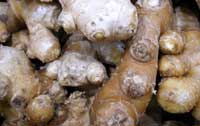Grow edible ginger
Ginger (Zingiber officinale) Common ginger, Cooking ginger is an exotic herb native to forest of tropical Asia. It is mainly grown for its aromatic, edible root that is used in cooking as well as medicinal purposes.

Edible ginger starts easily indoors and can be moved outdoors in warmer temperatures. This rhizome can be obtained at the grocery store in the produce section. Choose a firm, plump rhizome with ‘eyes’ (growing point). You can break up or cut larger pieces to 2″ size but be sure each piece has at least two or more growing points. Let the cut surface dry for a few days before planting. Place the rhizome horizontally 1″ deep just under the soil surface and plant in a large (12″) pot to allow extra surface space for the rhizomes to spread. Keep the soil warm and moist but not soggy. Cover the container with a plastic bag to maintain a humid greenhouse environment. Once the shoots emerge, remove the bag and move the pot to indirect light.
When night temperatures are above 55F take the plant outdoors. You can plant or bury the container in your flower bed. Ginger likes hot and humid growing conditions. Be sure it gets 2-4 hours of full sun (light shade), enough water and fertilize every 2 weeks. Since it takes at least 5 months to produce rhizomes an early start indoors will increase ginger root production. Plant it in April and it should be ready to go outdoors in May. The reedlike foliage can grow to 2-4 ft tall. In warmer climates, (zone 8-12) ginger can be planted directly into the soil. Shoots should emerge in May and can be harvested in Oct. /Nov. when the foliage turns yellow and dies back.
Don’t expect any flowers the first year, ginger needs to be 2-3 years old to bloom. Though rarely seen, it will produce an inconspicuous green spike with small yellow green fragrant flowers and purple edges when in bloom.
In cooler climates, ginger needs to be brought indoors before a freeze. Once the foliage dies, you can harvest some of it and save the rest for next year. Store the rhizomes in its container keeping it on the dry side or dig up the roots and store in a box filled with peat moss. Be sure the roots don’t dry out. An easier way is to buy fresh rhizomes in the spring.
Be aware that there are other types of tropical ginger some are edible and some are not.
Is the(Jengibre Lirie Abigarrado)edible. Common name is the Varigated Ginger Lily.
sorry, I’m not familiar with this ginger lily.
Are the leaves of the “shell ginger” flowering plant suitable for cooking?
I just want to add that if you’re not careful with growing ginger in the ground, it will spread if not maintained. The ginger plant loves to send growing nodules along it’s root system the will sprout more plants. All forms of ginger do this, and they can make a jungle of your yard. I’m talking from experience on this one for I just got done taking down all the ginger that took up the entire side of our house.
I have a LOT of ginger plants (the kind that has blooms below the leaves) at a home I just purchased, and I’m not sure how to prepare them for winter. The stalks & leaves are now yellow and bent over and we are close to our first frost. I think I live in zone 9 (southern Louisiana). I don’t want to lose them, the flowers are beautiful in May. I don’t believe the bulbs were ever dug up and replanted, we bought the house in early spring, and I almost pulled them all because I thought they were weeds! Help!!
You mention that you do not know of other edible gingers and I have a couple. I especially like Galangal, (Spice Ginger) Alpinia Galangal or Thai ginger. It is a true member of the ginger family and I personally use it a lot in every type of cooking both in a powdered form and fresh. It has a more complex spicier/earthy flavor and aroma. Growth requirements are about the same; it grows 5-6 feet tall and puts out a pretty yellow scafolded erect type flower–not as pretty as some of the inedible more exotic types. Also, consider Curcuma Longa, this ginger is the source of turmeric, grows 4 feet in full sun and has a lovely upright primarily white flower with yellow tips on the lower pedals and lavendar tips on top.